Context and Challenge
According to research funded by the Charles Darwin Foundation and the Galapagos National Park Directorate, 22 ant species were introduced to the Galapagos Islands. These included the big-headed ant and the deadly flame ant. Both are listed among the top 100 invasive exotic species around the world. These insects are a threat to birds, plants and invertebrates. They also pose a danger to nesting areas of giant tortoises. They also have a significant impact on local economies, as they pose serious challenges to agriculture.
In order to address this issue and to strengthen conservation efforts, the Galapagos Biosecurity and Quarantine Regulation and Control Agency ABG (the Galapagos health authority) has committed to financial support. The ABG aims to control and prevent invasive species and develop effective management techniques for urban, agricultural, and rural areas. They also aim to prevent the introduction and spread of new species such as ants.
Control and Monitoring Strategies
Biosecurity agents patrol strategic areas like docks, markets and waste collection centers. They use baits such as sausages, peanutbutter, tuna and honey to attract and detect ants. The ants collected are then analyzed to determine whether they are a new species. These data are crucial for the implementation of control measures in agricultural and urban areas. In addition, farmers are involved in field interventions to control ant populations and protect crops. To simplify the identification and control of ants, a digital catalog will be created. This will provide technicians and producers with accurate tools and timely information to address these threats.
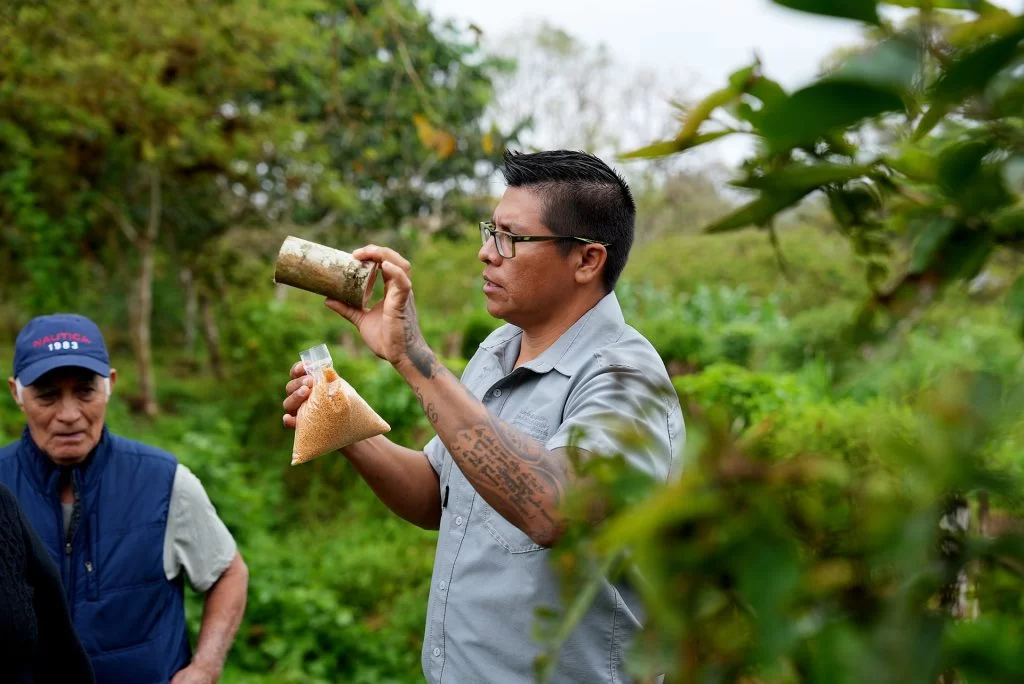
Ronal Azuero, Biosecurity Agent of the Agency for Regulation and Control of Biodiversity and Quarantine for Galápagos (ABG), shares knowledge with local farmers and producers, guiding them in the effective application of products to combat invasive ants. ©Galápagos Conservancy
Uniting Forces for the Future
Marilyn Cruz, executive director of the Galapagos Biosecurity Agency explains that fighting invasive species requires strategic alliances. We are grateful for the Galapagos Conservancy’s invaluable support, which improves our prevention control and eradication efforts. Together, we protect this World Natural Heritage Site,” she highlighted.
This initiative is crucial not only to preserve the unique Galapagos ecosystems but also to ensure a sustainable future, especially in agriculture and tourism. According to Dr. Jorge Carrion from our Conservation Department, ants are an invasive species which threatens the ecological stability of the archipelago and impacts agricultural production. He said that ant colonies can directly harm the eggs of giant turtles. The hatchlings of these tortoises are also vulnerable to ants. This has led to the death of many young turtles.
We commend the Galapagos Biosecurity and Quarantine Regulation and Control Agency on their persistence and dedication in reducing the impact of invasive species. This collaborative, united approach shows how we can protect local economies and, most importantly, conserve Galapagos’ natural heritage for future generations by working together.
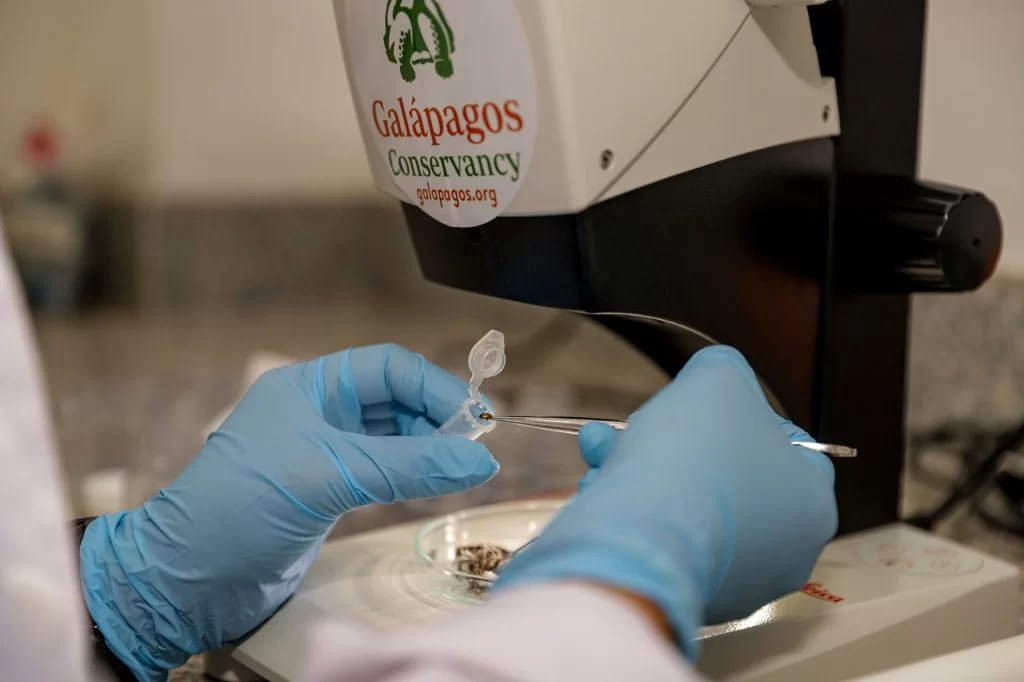
In the laboratory, experts meticulously examine ants collected during interventions by Biosecurity Agents. Accurate species identification is essential to develop effective control strategies. ©Galápagos Conservancy
Promoting Responsible Socioeconomic Growth
These initiatives demonstrate a wide range of conservation strategies. Some of these initiatives are directed at conservation efforts, especially those that are led by local groups, while others aim to engage youth through interactive environmental education. These projects aim to inspire a lifetime commitment to environmental stewardship in the next generations. A number of projects aim to increase local production and consumption, and promote sustainable living and healthier lifestyles. This multifaceted approach reflects the innovative and diverse strategies used to meet Galapagos’ unique conservation and sustainability issues.

Luis Sánchez, a recipient of our conservation grants, leads groundbreaking fungal research on Santa Cruz Island, crucial for environmental management. ©Galápagos Conservancy
Commitment and financial investment
Amy Doherty revealed that more than $500,000 had been allocated to 26 new local initiatives as part of this important fifth grant round. Amy Doherty, our Vice President of Operations, revealed that over $500,000 has been allocated to these 26 new local initiatives in this important fifth round of grants. Since the launch of the program in 2021 we have invested almost $5 million into local initiatives that focus on conservation and sustainable development in the archipelago. Amy stated that this latest round of funding “reaffirms the unwavering commitment we have to the prosperity of Galapagos and its ecological integrity.”
Galapagos Conservancy is proud to have supported 161 projects since 2021 on Santa Cruz and San Cristobal. Isabela has also been supported, as well as Floreana. These initiatives, led by women who are inspiring, entrepreneurs and local institutions, show our commitment to a model of sustainability that strikes a balanced between economic development and environmental preservation while promoting community well-being. Each project demonstrates the power of teamwork in transforming a sustainable Galapagos to future generations.

Novarino Castillo’s agricultural nursery, a sustainable farming initiative, thrives with the support from Galápagos Conservancy grants. ©Galápagos Conservancy
Natural Wonders of Espanola Unveiled
Espanola has a rich biodiversity, including endemic species such as the Galapagos albatross, Phoebastria Irrorata – the largest bird in the archipelago – and the Cactus Finch, Geospiza scanners. Espanola’s rich biodiversity makes it a key focus for conservation and scientific research.
The Galapagos Islands Initiative Program: A Journey of Conservation
Galapagos Conservancy and the Galapagos National Park Directorate will embark on a series expeditions in Espanola, 2023. These missions were part of one our most successful programs Initiative Galapagos and aimed to protect and restore the island’s eco-systems.
The first expedition, under the leadership of Washington Tapia as executive director and scientist, released 86 young Chelonoidis Hoodensis turtles in March. The tortoises were bred in captivity and reintroduced into their native habitats to boost their population. They are vital to the ecosystem and landscape of the island, which benefits other species including albatrosses.
The next expeditions, in August and June, focused on the monitoring of vegetation and a census of albatross populations. These studies were designed to better understand the interaction between tortoises, the island’s vegetation and albatross populations. The preliminary findings indicate a stable population of albatrosses, although the effects of El Nino were evident.
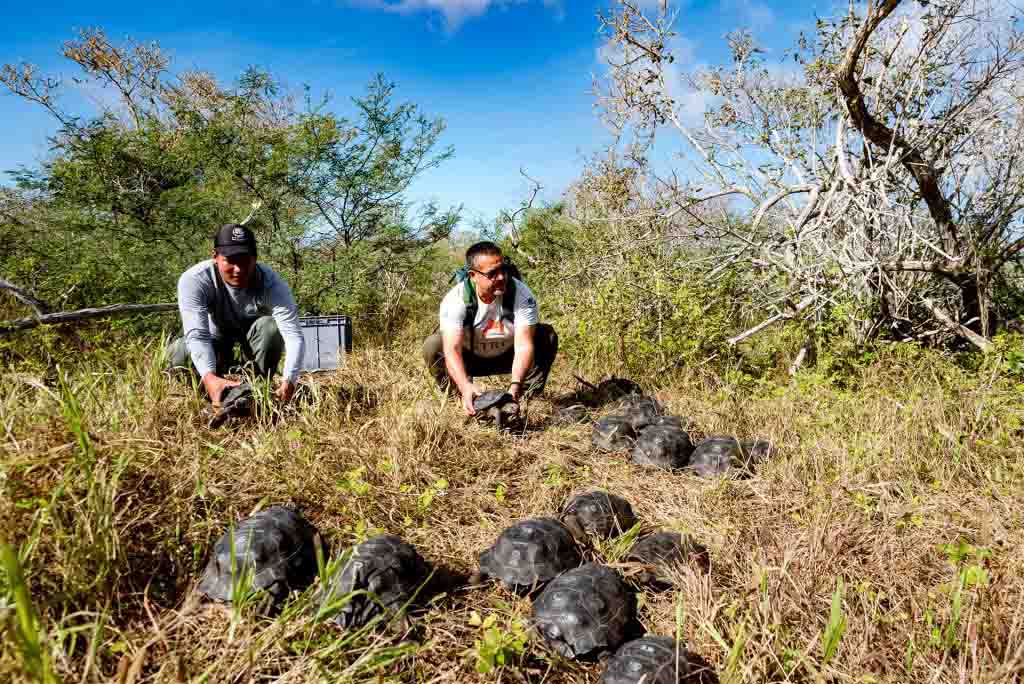
Park ranger Wilson Villafuerte (left) and scientist Washington Tapia release 86 tortoises on Española Island, a key step in the island’s giant tortoise restoration process. ©Galápagos National Park
Face challenges with resilience
Espanola’s biodiversity is still under threat, despite significant conservation efforts. Our conservation director Dr. Jorge Carrion says, “The Galapagos Islands not only serve as a natural laboratory, but they are also a magnet to global tourism. Species like the albatross draw visitors from around the world.”
Iniciativa Galápagos is a great example of the power that collaboration can have. We work closely with the Galapagos National Park Directorate to unite passionate scientists and dedicated rangers on a shared mission of conserving Espanola, the entire archipelago, and experts. This commitment goes beyond local efforts and resonates globally in our quest to conserve this remarkable part of the planet.
The Future Generations: A Commitment
Our expeditions in Espanola demonstrate our commitment to protecting this unique ecosystem. We are dedicated to making the Galapagos Islands a beacon for sustainable tourism, and a testament of the wonders that biodiversity can bring. Carrion summarizes our mission by saying, “Our work is more than conservation. It’s a heritage we are building for the future generations.”
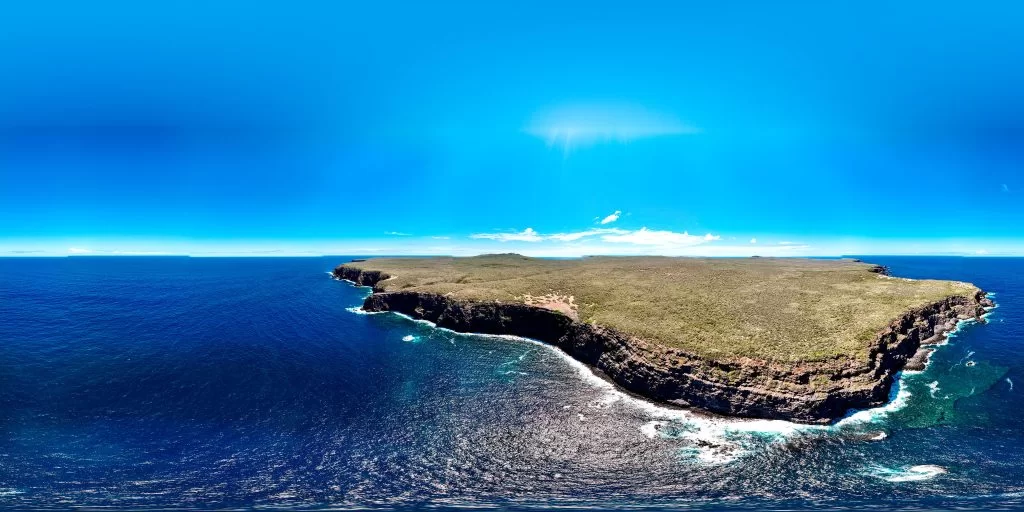
Panoramic view of Española island, spanning 60 km² and renowned one of the oldest and most diverse islands in the Galápagos Archipelago. ©Galápagos Conservancy
Monitoring Critical Climatic Conditions
In a major step for research, the Ecuadorian Navy’s Oceanographic and Antarctic Institute has deployed a second oceanographic beacon in the Galapagos Archipelago. The buoy will be used to monitor environmental conditions and in particular those related the El Nino phenomena. This device is a complement to another buoy that was placed earlier in 2023, 110 nautical miles away from the Santa Elena Peninsula.
This expanded ability to collect environmental data will enhance preventive and protection measures for the Galapagos Archipelago. The buoys have sensors that capture a wide range of oceanographic and meteorological data including air temperature, wind direction and speed, precipitation and atmospheric pressure. They also measure wave patterns and ocean currents.
The collected data, which is of utmost importance, is sent to INOCAR’s Ocean Monitoring Center, in real time, where it is analyzed and used to produce climate forecasts. These forecasts are crucial for a wide range of activities, from navigation and fisheries to risk management and science research.
The Commitment to Protection Continually
Dr. Jorge Carrion is our Conservation Director and he emphasizes the need to monitor El Nino’s impact on Galapagos. “Protecting Galapagos ecosystems requires a constant and meticulous effort.” He says. We are committed to being vigilant and to taking quick actions to protect the integrity of these eco-systems from any anomalies caused by El Nino.
We are unwavering in our commitment to protect Galapagos, its biodiversity and the natural environment. We can continue to work tirelessly for a safe future for this natural treasure thanks to the generosity of our donors.

Through continuous tracking and data analysis, the buoys can predict phenomena like El Niño, which significantly impact global weather and oceanic conditions. ©INOCAR Ecuador
Galapagos Conservancy is proud of its efforts to reduce the use of single-use plastics. Few years ago, these plastics were a serious threat to the unique ecosystems of the archipelago, especially the marine environment. Galapagos’ use of single use plastics has decreased significantly since a program was launched to reduce its use.
Galapagos Conservancy is committed to supporting local communities’ involvement in conservation and sustainability on Galapagos. We can preserve the natural beauty of Galapagos by promoting responsible and sustainable practices, and educating the public on the importance to protect the environment.
They act as natural ocean cleaners. The sea cucumbers clean the ocean by consuming debris and sediment. This activity is crucial for maintaining healthy marine ecosystems. The sustainable management of sea cucumber fishing within the Galapagos Marine Reserve has a high priority, both from a socioeconomic and an ecological perspective.
On October 1, 2023, a new sea cucumber fishing season was authorized within the Galapagos Marine Reserve. The decision was based on strict technical criteria, outlined in a five-year fishing schedule and backed by extensive monitoring that indicated the sea cucumber population recovered enough. The opening of any fishing activity in the region must be approached with caution to ensure that this valuable marine resource is conserved and used sustainably.
Local fishermen can only harvest sea cucumbers if they have valid Artisanal Fishermen of the Marine Reserve licenses (PARMA), issued by the Galapagos National Park Directorate. The permits allow the holders to also participate in other fisheries approved within the Galapagos Marine Reserve.
Commitment to sustainability and the future
On October 25, the Environmental Authority Resolution No. 203 for this year, which established a catch quota set at 600,000 sea cucumbers, was reached. On October 25, the 203 quota for this year was met. The commercialization of sea cucumbers and the transportation period ended on November 2, 2020.
This shows that the government is committed to finding a balance between resource use and conservation. The fishery was limited to certain islands while important conservation areas such as Bolivar Channel were designated as nurseries with no harvesting permitted.
Galapagos Conservancy supports an ecosystem-based management approach, which recognizes the ability of ecosystems to sustain local communities. This approach is demonstrated by the recent sea cucumber fishing, which demonstrates that it is possible for species and habitats to be conserved while still meeting local needs.
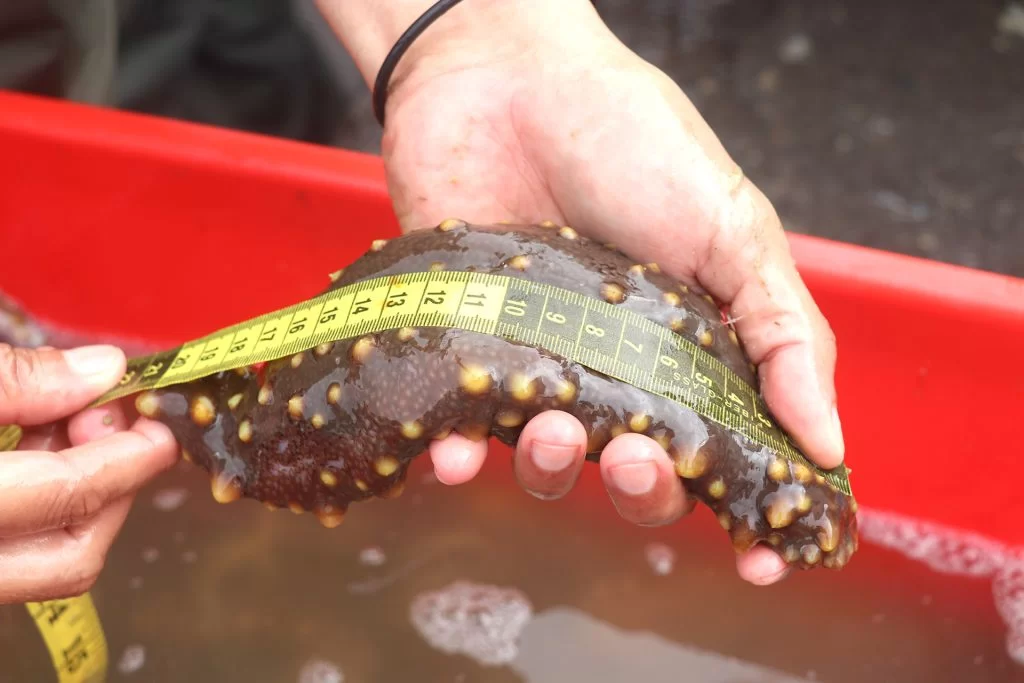
As part of the management measures to ensure resource sustainability, Galápagos enforces minimum catch size of 7.9 inches fresh and 2.8 inches processed for sea cucumbers. ©Galápagos National Park Directorate
Galapagos: A Global View
The Galapagos archipelagos efforts to foster harmony between humans and nature are an inspirational global model. The Galapagos Archipelagos’ practices and commitments demonstrate the possibility and necessity of a coexistence between humans and nature. This lesson is applicable worldwide.

Park rangers Galo Rueda (L) and Gonzalo Sevilla enforce fishing regulations in Galápagos to conserve marine resources. ©Galápagos National Park Directorate